Welcome back to The Ultimate Guide to Magic Spellslingers — on this, the #1 source for Spellslingers content in literally the entire world, because no one but the game’s own Developer Diaries has run more than our humble seven (VII) pieces on it.
I’m your host, Hipsters Content Manager Sinistra Black. Last week I introduced the series and ran through the gameplay basics, card types, and core mechanics of Spellslingers, with a special eye toward preparing Magic: The Gathering veterans for ways this game both dovetails with and differs from Magic. If you haven’t played any Spellslingers or feel disoriented by the game’s mix of MTG and not-MTG, start there.
In this installment, we’re going to go through the monocolored Spellslingers and talk about what makes each special; archetypes forming around them; and sharp corners to look out for both with and against them. For the sake of simplicity, I’ll be going through them mostly in the order they appear in on the ‘Slinger selection screen.
This is not a tier list of Slingers ; we’ve already published one of those by new writer Ryan Hay (who found us by joining our public “Hipsters” Spellslingers Team, only later realizing we were these Hipsters). There’s a lot to talk about with each Spellslinger, so be aware that these breakdown episodes will be on the longish side. Feel encouraged to bookmark this piece or keep the tab open, and treat it like a batch of mini-articles on each Spellslinger that you can read one at a time.
At the time of this writing, Magic Spellslingers is available on iOS, Android, and Steam.
The following table of contents will evolve and change as new entries in the series are published, and will always link to each published entry.
- Part I: Introduction
- Gameplay Basics
- Card Types
- Core Mechanics
- Part II: Spellslingers and Archetypes (This page)
- The Monocolored Slingers
- Part III: Spellslingers and Archetypes
- The Allied-Color Slingers
- Part IV: Spellslingers and Archetypes
- The Enemy-Color Slingers
- Part V: Building Your Collection
- The Lower Leagues
- The Endgame
- Part VI: Advanced Strategy
- Tempo on the Draw
- Curves + Ratios
- Variant Builds
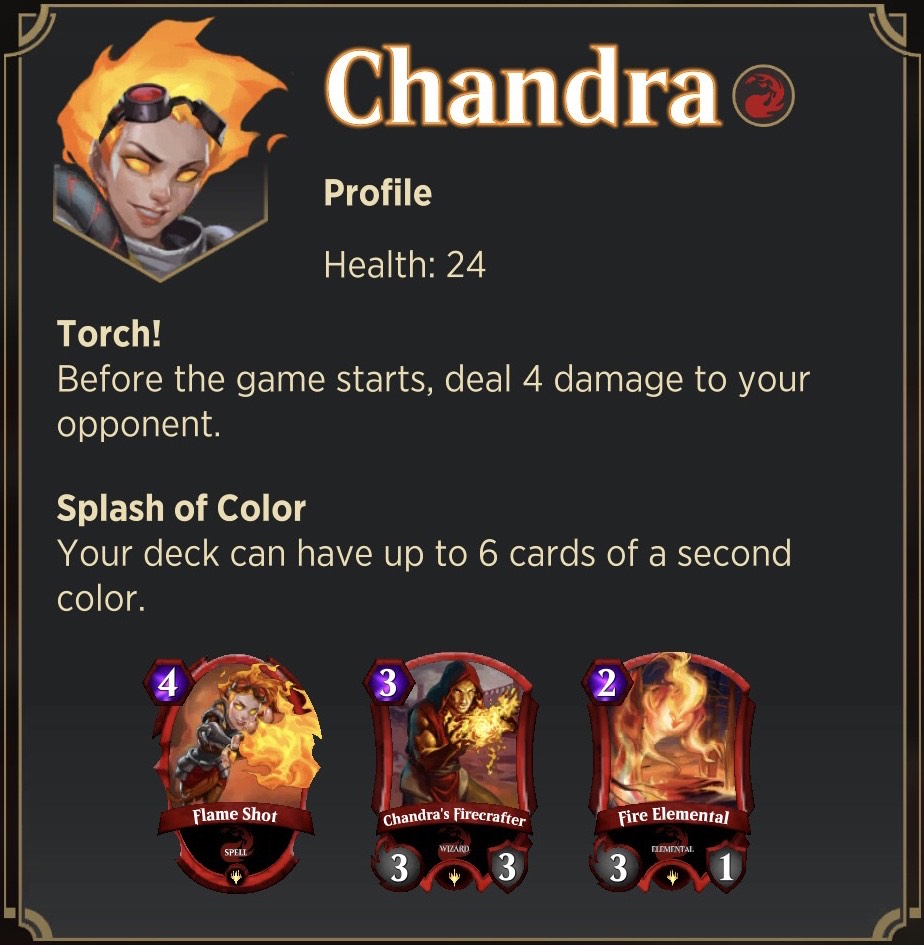
Torch! me hot mama (NOTE: Fire Elemental is now a 3/2)
Chandra
As I mentioned last week, Chandra is the one Spellslinger every account starts out with before earning any Keys toward unlocking more. She’s geared toward aggressive red strategies, but does have the tools to play a more midrange defense when necessary.
Unique Traits
Her unique ability “Torch!” is as clear-cut as it gets, dealing 4 to the dome on Turn 0. Like all five of the game’s original monocolored Slingers, she has “Splash of Color” — which is just a fancy way of saying that by default, monocolored Slingers can run up to six cards of a single splash color (including two-color cards sharing their base color).
Unfortunately, 4 damage up top is not as strong as it sounds to an MTG enjoyer, because this is a game where most characters start with well over 20 life. Because Chandra herself has exactly 24 life, her mirror matches are the closet thing the game offers to a direct facsimile of Magic tempo.
Where Chandra really shines is in her Signature cards. Fire Elemental, recently buffed into a 3/2 that Shocks your opponent when it attacks, is one of the best two-drops in the game. Chandra’s Firecrafter, a 3/3 for 3 that gives you a random red damage-dealing Spell or Trap, is costed well for both beatdown and defense scenarios — and it can give you an off-splash multicolored card, like pulling a juicy Lightning Helix even if you’re in red-black.
Her best card period is Flame Shot, a four-mana Spell that deals 3 to a target enemy and 1 to each other enemy — which means it can conditionally be one-sided board wipe, and always deals some damage to your opponent. Anytime you get to Bolt their face and ping their whole board away, you’ll leave feeling like maybe Flame Shot is OP.
The Buried Lede
The tricky thing about Chandra is that, paradoxically relative to Magic, you can’t really build that tight of a Red Deck Wins build around her with your initial collection of Commons and Core Set (silver symbol) cards. And because life totals are so much higher here — even though many creatures have a stronger mana:P/T ratio to accommodate that — assembling 23-30+ can be tricky until you have access to explosive Epics like Ball Lightning and Hellrider, or efficient Rares like Pouncing Lemur.
Also, the best Chandra lists often play like tempo decks, looking to temporarily neuter key blockers rather than worry about hard removal. Both my Chandra lists run a full suite of Shock, Burn Through, and Goblin Shortcutter; this package is a linchpin of red aggro that you’ll see again and again in future chapters. Opening Salvo and Molten Misstep have their place as well, but they’re more conditional and subject to Trap timing complexities.
In my experience, the best Chandra decks are either monored or splash black for options like Pact of the Warlock, though I also have a pet deck called “Big Red Dog” that centers on putting green buffs on tramplers or Two-Headed Hellhound.
What to Watch Out For
Despite what I said above about her 4 damage not being that great, or her build not fully shining without a stronger collection, you do have to respect the existence of Lava Axe; it seems to be a really good finisher in this game even though it was never very competitive in Magic. Try to be above 5 life before passing to a Chandra who’ll have 5+ mana.
Lastly, by being both the first Slinger you get and the default Burn/”Sligh” character (I’m showing my age), Chandra also presents an opportunity to bring up a crucial point I alluded to briefly: because mana development in this game is guaranteed barring optional land effects, be prepared for any deck to potentially run a few high-cost, game-altering windmill slams.
I have absolutely been blown out by a low-to-the-ground, aggressive Chandra deck that unexpectedly dealt 6 to my entire board with the eight-mana control/ramp staple Lava Wave, or turned all their troops into dragons with the nine-mana Draconic Transformation.
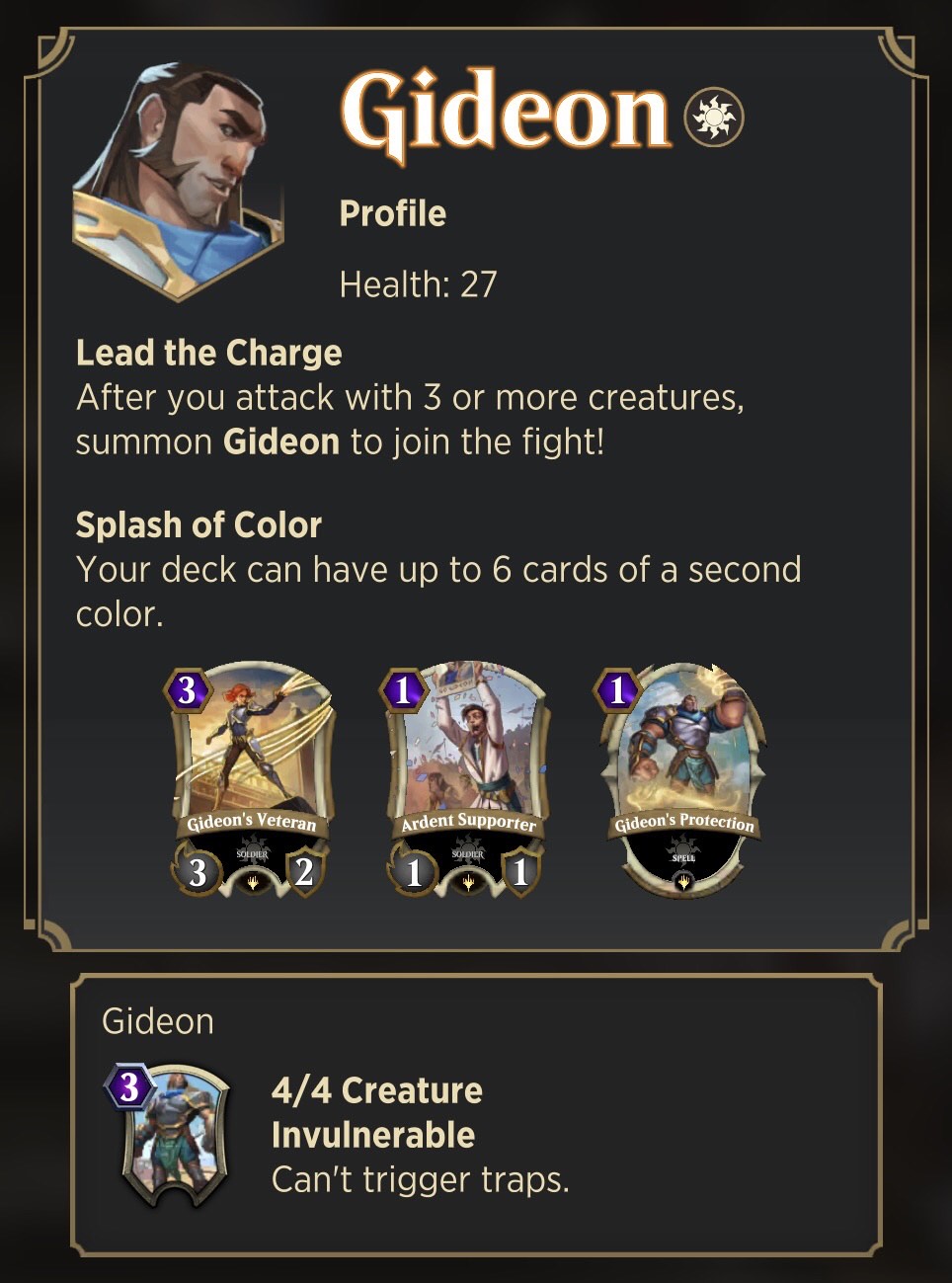
Daddy’s always showing up and leaving (NOTE: Ardent Supporter is now a 2/1)
Gideon
Gideon is the game’s White Weenie general, strongly incentivizing you to go wide. I was skeptical before testing him out, but he can generate some explosive starts that challenge the perception of Chandra as the default monocolored aggro Slinger.
Unique Traits
Unlike Chandra’s “Torch!” ability, Gideon’s “Lead the Charge” is the centerpiece of how you build and play him. Whenever you attack with three or more creatures, Gideon pops in as a 4/4 attacker that can’t take damage or trigger Traps — then goes away at the end of combat, which is not signaled well in the app. Even as a Geist of Saint Traft-like combat “token,” however, Gideon calls Chandra’s math into question: if you get through with him for even one hit, you’ve replicated her ability and started the game with 27 life, three more than hers.
His unique cards are not quite as eye-popping as Chandra’s, but they’re good enough and serve his game plan of “preserve the Battalion trigger” well. Ardent Supporter is now a 2/1 for 1 that gives you a random white creature card of cost 2 or less, which again can even give you an off-splash “gold” card like Watchwolf. Gideon’s Protection gives a creature armor and gives Gideon +1/+1 for the game, and Gideon’s Veteran is a simple 3/2 with armor for 3. Armor is deceptively essential to most Gideon builds, in that it enables a creature to block, “trade,” and still attack again — or to rush headlong into combat no matter what’s on the other side.
The Buried Lede
Gideon is one of the more straightforward Slingers, to be honest. Play out creatures and attack with them to get…even more attacking to happen. Where his subtlety arises is in how you block and when you choose not to attack. Sometimes you have the momentum, mana, and card advantage to swing out every turn and then refill your board; other times you need to attack selectively with exactly the three creatures that represent losing the least position, or simply pass turn because the 4/4 isn’t worth the costs of battle.
Similarly, sometimes in a race you may need to just let yourself take damage in order to preserve a consistent stream of Gideons every turn. In other cases you may be forced to block as needed, forget about Gideon for a few turns, and play to the outs in your deck that will allow you to re-establish a board state.
The best Gideon decks tend to splash red, because hasty creatures like Raging Goblin, Goblin Fieldrusher, Skyknight Legionnaire, Tajic, Inferno, and even Zo-Zu enable you to surprise the opponent with Gideon triggers when you appear to be representing only two or even one potential attacker. Blue splashes have also seen an uptick as players have learned to build around synergies like Spawning Arowana and Blink Dog Pack with Paragon of Balance and/or the blue-white pseudo-enchantment Fair Fight.
What to Watch Out For
As with Chandra’s interaction package above, many solid Gideon lists exploit the synergies between Untested Rookie or Beginner’s Luck and Shields Up or Gideon’s Protection. Apart from Gideon’s unique Protection, this is a potent package that will appear in many white aggressive or midrange lists.
Remember that Rookie and Luck don’t care how the creature survives. If Drizzt attacks you with a 1/2 cat trigger early, you can block the cat with the Rookie and have a 4/3 for 1 mana. Likewise, if a green player carelessly chump-blocks into either of these cards with say, a Birds of Paradise or Kiora’s 0/1 Fish, it still counts as “surviving combat” even though there was no damage to survive.
Lastly, although I sometimes refer to the 4/4 as a “token” for simplicity, know that it does in fact count as “summoning” in game terms. That means that, for example, a green-white build with a Centaur Sage out will draw a card every time Gideon pops.
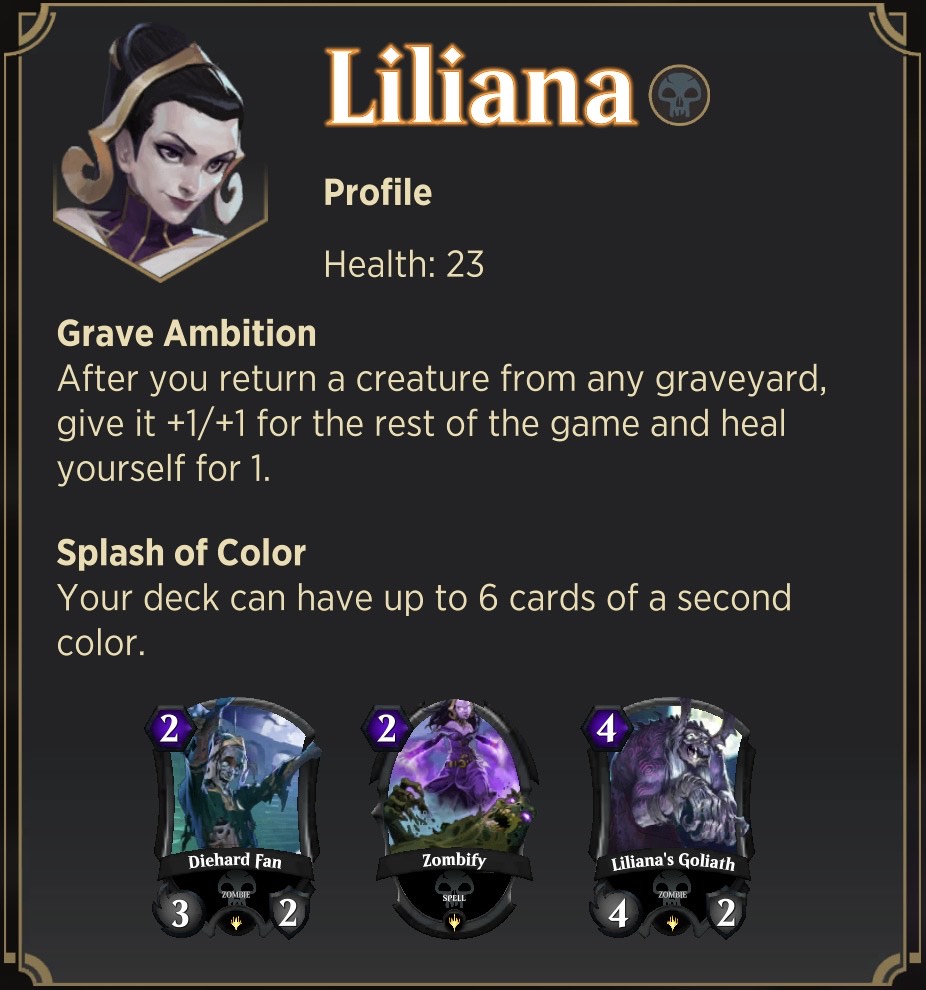
at least zombies always come back to me
Liliana
Liliana is straight-up the best Slinger to focus on in early leagues, when your collection is still limited. No contest. At a point in your Spellslingers journey where Jace looks like trash and Nissa lacks endgame, Liliana offers simply unparalleled board dominance.
Unique Traits
23 health is a pretty average starting life for a Slinger, but Liliana’s “Grave Ambition” means that if you build and pilot her well, your true life total is 30+. The ability is more complex than the last two, so read it a few times: “After you return a creature card from any graveyard, give it +1/+1 for the rest of the game and heal yourself for 1.”
There’s a lot to unpack there. Note that it does not say “to the battlefield”; in other words, returning a creature card to your hand with Gravedigger will trigger this just like reanimating one with Zombify or Fearsome Return. Next, remember that it says “any graveyard,” which has become relevant since the release of Ebondeath in D&D Icons. And most importantly, where it says “for the rest of the game,” it works just like the term “perpetually” in Magic Arena‘s Alchemy format: the +1/+1 will follow the card to any zone, meaning you can return that creature more than once to accumulate buffs.
The star of Lili’s Signature suite is Liliana’s Goliath, a four-drop nerfed from 4/3 to 4/2, whose power doubles when it leaves your graveyard — including via its own relentless ability. It does not say “for the rest of the game,” so its power will un-double when it dies again; but the doubling takes place after it gains Liliana’s +1/+1. In short, it works all the ways you want it to work, as long as you remember that it’s not a “perpetually.”
Lili’s other uniques are more conditional. Zombify drafts a Zombie from your graveyard for just 2 mana. Where most draft effects in the game always grant three options, here your options are determined by game state; if you have three or less Zombies in the yard, you have your pick of the dead. This is especially great in the mid- to late game, where you often get back something worth more than Zombify’s cost of 2. If you take the obvious bait and build around relentless creatures, their relentless triggers also mean it takes longer to pass the three-dead-Zombies threshold than you may expect.
Diehard Fan is a 3/2 for 2 with a Finale that makes all Zombies in your hand cost 1 less. This is very good when you play it in the first turn or two, trade it with something equal or better, and then get to cast either a Goliath and/or a salad of 1-, 2-, and 0-drop Zombies your next turn. The rest of the time, it’s a 3/2.
The Buried Lede
Most importantly, know that the player base pretty quickly figured out that the best splash color for Liliana at this time is green. Turns out that when your game plan involves making a lot 10/3s and the occasional 6/6, granting things trample is pretty darn good. I’ve seen all of the trample-granting effects currently in existence applied to Liliana decks, but the consensus seems to have converged around the lowly Horncharge Lantern for its ability to grant trample twice on separate turns, as well as the way it helps fill your curve as an early investment for a later payoff.
Black also has a few reasonable discard outlets so far, so I’ve also experimented with Liliana as a base for building Black-Red Reanimator. Red gives us the best reanimation targets at this time, like Darigaaz and Spawning Hellion, as well as potential enablers like Mana Surge and Looting Lizard. I don’t think this deck is “real” just yet, but one day I think a list like this will be viable, and we’re already inching closer with Ebondeath, a dragon that works well as either a reanimation target or a reanimation spell (though not both at once).
What to Watch Out For
In all honesty, the thorniest thing about Liliana is that after playing her a whole bunch, as you should early on, you may start getting it in your head that relentless gives creatures +1/+1 or includes life gain. To this day, every time relentless triggers in a non-Lili deck, I have a little moment of remembering that they come back the same size.
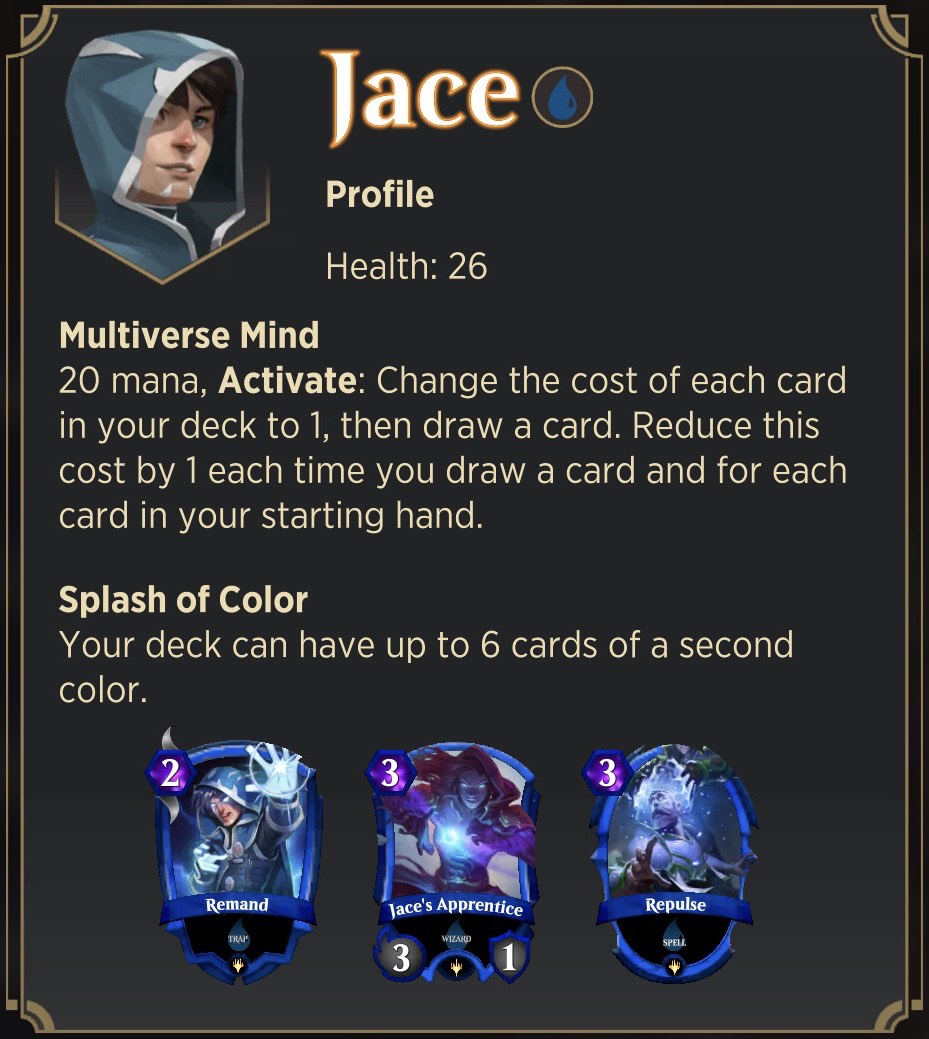
look at this showoffy fuccboi
Jace
I’m going to be blunt: until you develop your collection, Jace kind of sucks. I honestly didn’t get what they were going for with him until I saw what a dedicated control deck looks like in Spellslingers — and as in both Magic and life, control is an expensive end.
Unique Traits
“Multiverse Mind” is one of the more involved Slinger mechanics. It’s a 20-mana activated ability that you can only activate once, and it gets cheaper by 1 every time you draw a card — including your opening hand, which means it really starts at 16 or 17.
What does it do? It makes every card in your deck cost 1 and then draws you a card. This means that the same types of cards that enable the ability — ones that draw cards — also profit from it, enabling an endgame where you can chain together a flowing stream of cards for 1 mana gem apiece. Some players like to activate it as soon as they’re able to do so with 1 spare mana for that first cheapened card; personally, I prefer holding off as long as possible, sometimes until it costs 0, or until I have put cards into my library that I want to reduce the cost of. (More on that in a moment.)
Jace’s Signatures are very good. Remand costs 2 and counters the first card they play that costs 3 or more, returns it to their hand, and draws you a card. Repulse works much like Magic‘s Repulse, bouncing an opposing creature and drawing a card for 3. Jace’s Apprentice is a 3/1 for 3 with ward, whose Debut gives her +0/+1 for each card in your hand at that time. For a hot minute I thought the Apprentice was unnecessary, but it’s proven itself a valuable roadblock against aggro onslaughts.
The Buried Lede
What’s interesting to me about Jace is that a lot of builds that really maximize him just look like versatile, well tuned control piles even without his ability — which is what makes it kind of terrifying when you let him survive long enough to activate. What his ability brings to the table is not just the reduced cost of everything left in his library, but the extreme consistency and card selection it incentivizes you to build your deck and your early turns around in the first place. Jace insists that you build a good deck.
As such, you’ll notice that many powerful Jace builds center around planning toward one or two very specific endgame lines of play — even down to the last draw. Many of these endgame states revolve around manipulating the cards in your library with finishers like Arcanis, the Archmage, Second Sun’s Dawn, and Spawning Hellion, and/or manipulating your mana with tricks like Stern Artificer granting Energy Extractor an extra charge. As with Gideon above, you can also build a blue-white Paragon of Balance/Fair Fight list, which we’ll revisit some more next installment with Teferi.
What to Watch Out For
A crucial note about decking: in Spellslingers, you don’t lose the game when you would draw from an empty library, but when your turn ends with an empty library. That means you can safely do things like cast Divination with one card left in your deck.
It also means that you can empty your library, put new cards into it, and then use a cantrip, Wizard’s Spellbook activation, etc. to draw them right away. Cards like Spawning Hellion copies, Arcanis’s Mystical Arcana, and Second Sun. If you time your Multiverse Mind activation around powerful endgame plays like these, you can cast them super quickly for a dramatically reduced cost — and with a small enough library and/or a little luck, even the same turn you created them.
A couple of corner cases regarding Multiverse Mind: be aware that it sets every card in your deck to 1 — which means that if you’ve already somehow managed to make something in your deck cost 0, it will now cost 1. It also means that if you are running Tolarian Academy, any remaining artifacts should cost 0 once they enter your hand.
When playing against Jace, keep in mind that Multiverse Mind doesn’t change the cost of cards they’ve already drawn. It can be beneficial to note the number of cards in their hand at the time of activation, before the resulting draw, so you can keep track of how many non-altered cards remain in their hand.
Lastly, Jace’s set of incentives puts him at an enormous metagame disadvantage to Ashiok. We’ll cover Ashiok in depth next issue, but here’s the rule of thumb I use against them whenever I’m playing with Jace, Centaur Sage, or any other effect that draws multiple cards: the time to draw is often quite literally now or never.
If there’s an out you need to play to buried in your deck, you of course play to it either way; but the safest time to actively dig for it is almost always sooner rather than later…at least, until the turn where passing means losing anyway.
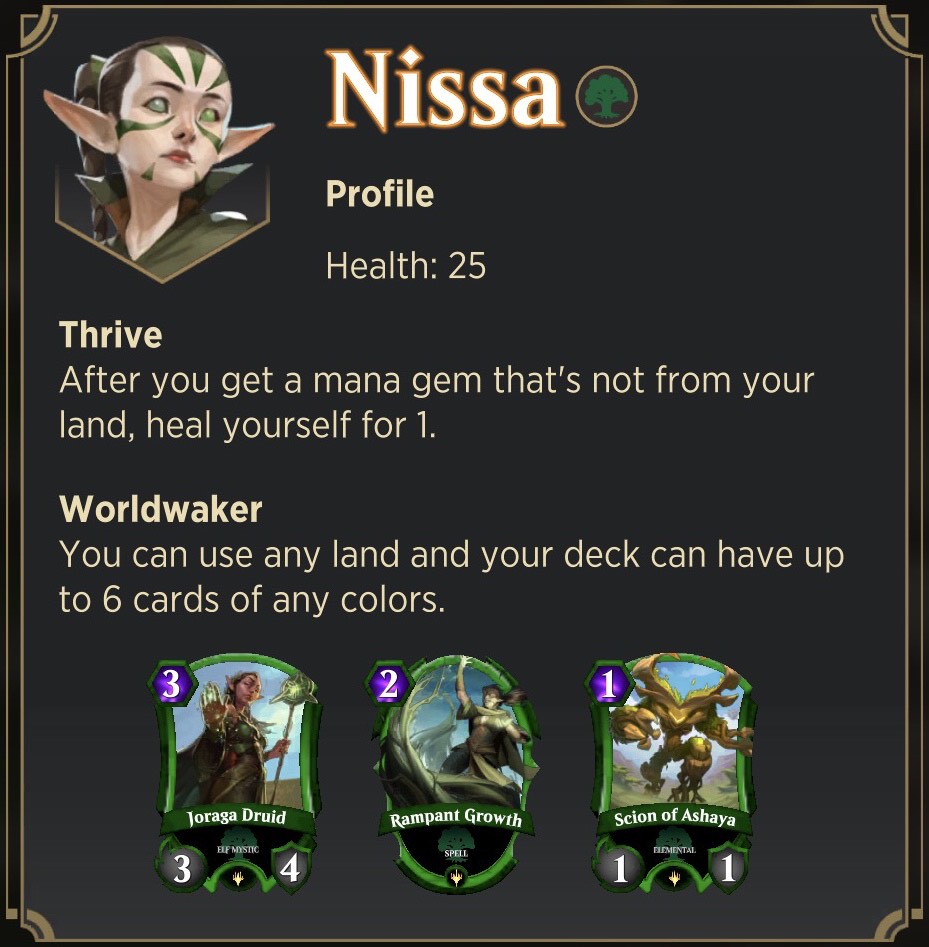
ok now THIS is mommy vibes
Nissa
Of the game’s five original monocolored Slingers, Nissa is the oddball. With ramp-fueled defense and card draw, and one of the most generous deckbuilding rulesets, she can play host to a wide array of midrange, control, and even combo strategies.
Unique Traits
On paper, Nissa starts with 25 life. Like Liliana, however, her “Thrive” ability means she usually starts with something like 28-30 life, healing 1 every time she gets a mana gem from any source other than her land. That includes empty mana gems from cards like Sylvan Shrine, as well as fragile mana gems from cards like Birds of Paradise — or the fragile mana gem you get for going second, which makes her literally start at 26.
There is one annoying exception: she doesn’t get life triggers from “temporary” mana that lasts for the current turn only, such as from Mana Surge or Old Gnawbones. I don’t know if that would be overpowered, but it is a confusing exception to her firmly worded text, and is currently not signaled in the game client whatsoever.
Her deck construction rule is the unique “Worldwaker” ability, which lets her use any land in the game and permits her six splash cards to be selected from all five colors. In many ways, this is the real reason for her existence in this game, providing a way to build diverse base-green decks where neither cost nor color limit your options.
For me, her Signature cards are two hits and a miss. Rampant Growth is basically like Magic‘s Rampant Growth: for 2 mana, you get an empty mana gem, which is this game’s take on a tapped land. The real powerhouse is Joraga Druid, a 3/4 for 3 that nets you a card for every mana gem that isn’t from your land — again, except for temporary mana — turning cards like Rampant Growth into cantrips and Sylvan Shrine into a strictly better Mystic Tome. When I was still playing two copies of Plot in my Nissa decks, I was actually drawing too many cards and losing tons of them to the dreaded “Full Hand!” notice.
Then there’s Scion of Ashaya, a “1/1” for 1 with trample and ward. When it Debuts, it eats all your remaining mana and gets +1/+1 that many times. Essentially, this is the Spellslingers version of a creature that costs X. I should probably give it a second chance now that my collection is stronger, but I can’t see it as more than a one-of that you hope to cast for 10 or more. Outside of a situation like that, it just never feels like what I want to do with my turn.
The Buried Lede
As you might imagine, Nissa decks can go all over the place. And like I’ve said about building control, a ramp strategy calls for some higher-rarity endgame plays to pay it off. So when your collection is limited, you may want to try for a more midrange approach with her, focusing on aggressive 3-to-6 costs rather than giant bomb finishers, and perhaps capping things off with a couple of Overruns (thankfully a Core Set card) and maybe one Crush of Wurms (thankfully a Rare).
Once your collection is robust, the sky is truly the limit. As of this writing, the most successful Nissa decks appear to be controlling builds that wipe the board with either Day of Judgment and/or Lava Wave, with an endgame often built around Crush of Wurms and/or a combo like Niv-Mizzet, the Firemind with Centaur Sage, or Strahd, Lord of Ravenloft plus Hasten for a one-shot finish.
However, Nissa doesn’t have to play control. My most successful original build so far is an Aggro Ramp list focused on spending turns 3-8 casting things like Force of the Wild; Omnath (no epithet? really?); Adult Behir; Old Gnawbones; Brawling Behemoth; Ilharg, the Raze-Boar; Akroma, Angel of Wrath; and even Hlaavin, Lord of the Unseen. As this game’s card pool widens and deepens, I look forward to seeing the creative Nissa builds players find.
What to Watch Out For
Probably the biggest caveat about Nissa is that her life gain is not as significant as it sounds. How many ramp decks have you ever played in one-on-one Magic where you needed to cast more than, I dunno, three ramp effects to get your action online? Without Primeval Titan for the repeat effect or a gross Joraga Druid hand (which does feel great), Nissa’s life gain is not nothing, but it can be nothing *compared to Liliana’s.
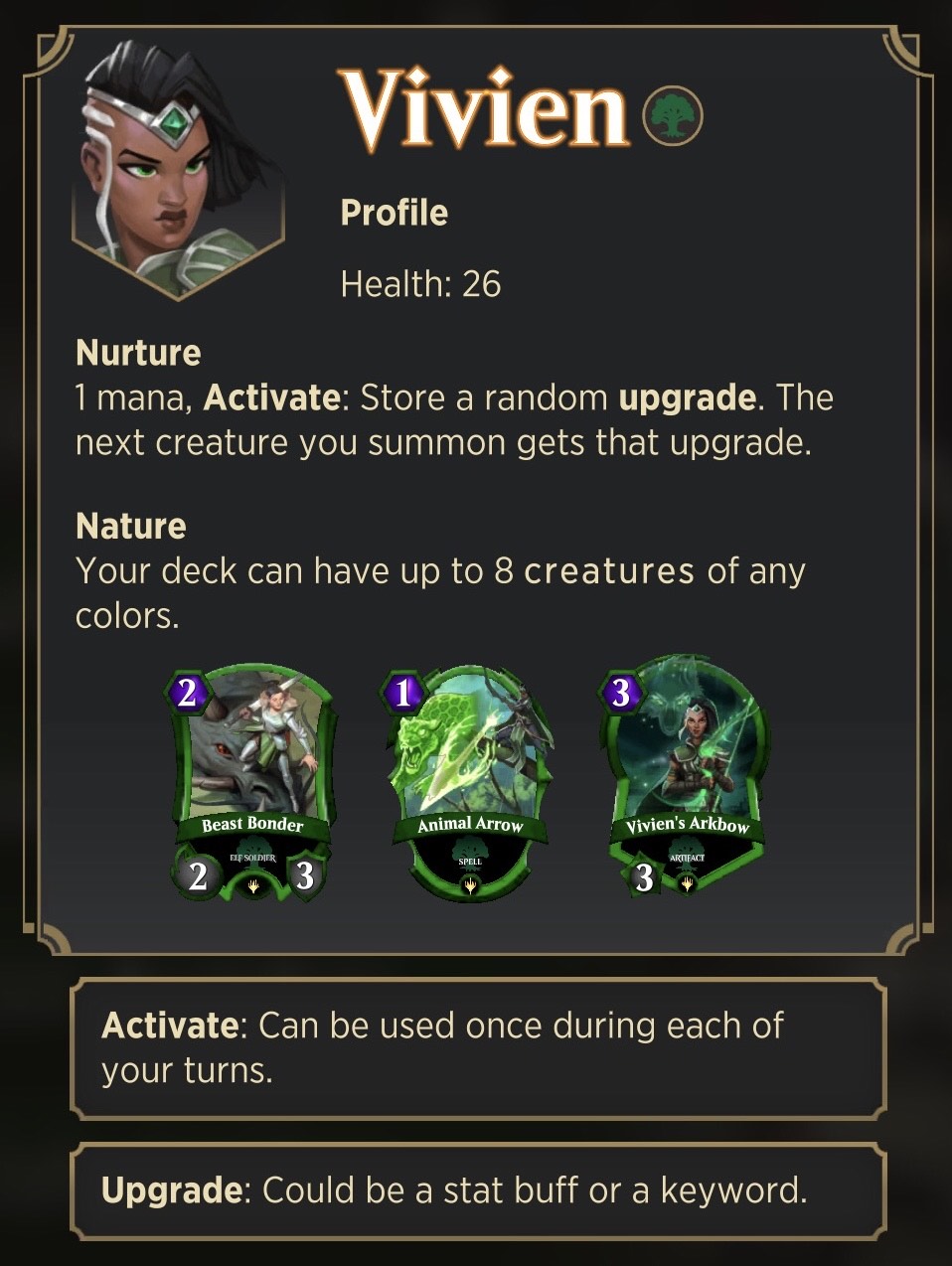
upgrade me femme daddy UwU (NOTEL: Vivien’s Arkbow now has 2 charges)
Vivien
Added to the game sometime during its extended beta period, Vivien is one of the more unique Slingers, with a randomized activated ability that skews how you think about your mana curve and offers a playstyle with high variance but high rewards.
Unique Traits
Vivien has 26 life, like Nissa on the draw, and “Nurture” gives her a one-mana activated ability that can be activated once per turn, which stores a random “upgrade” for the next creature you summon by any means. If you don’t like your current stored upgrade, you can reroll it next turn even if you haven’t summoned anything.
Okay. But what is an upgrade?
Why, an upgrade is any one of: +3/+0; +2/+1; +1/+2; +0/+3; flying; haste; trample; reach; ward; sneak; or armor. That’s all — real simple!
Vivien’s Signatures basically represent the three most obvious ways to interact with this mechanic, in a good way. Beast Bonder is a 2/3 for 2 that gets +1/+0 whenever one of your creatures (or creature cards in hand?) gets an upgrade. Animal Arrow draws a random creature from your deck and then lets you draft one of three random upgrades for it, which it then gets while in your hand (ah, there it is). Vivien’s Arkbow is now a two-charge artifact for 3 that lets you draft an upgrade for a creature you already control.
Then there’s Vivien’s subtler superpower: the “Nature” deck construction rule lets her splash up to eight creatures of any color.
Eight.
The Buried Lede
There are non-Signature cards that use the upgrade mechanic without being tied to Vivien, though most see little play outside her archetype. Stoneforge Mystic, the only highly played upgrade card outside Vivien lists, drafts a Mystic Weapon that gives +1/+1 and one of three upgrades. Briarfox gets one every time it attacks. Mobile Armory gives one to a random creature on your end step. Animalgamate, the best named card in Spellslingers, gives one creature three upgrades. Even Momir Vig interacts with his Kraj by giving it upgrades.
There are a few non-obvious qualities to upgrades. First, you need to think about not just giving upgrades for its own sake as a linear, parasitic cottage mechanic, but about what creatures get the most benefit from upgrades. Creatures with attack triggers (like Briarfox) or “when this damages your opponent” triggers typically get the most out of gaining evasive keywords or ward. Fight-starters like Spearcrown Stag or Brawling Behemoth get the most out of armor or toughness boosts; they also, like creatures that already have evasion, get extra mileage out of power boosts.
Then there’s a facet the game never outright tells you: when a creature in Spellslingers is copied, it doesn’t copy just the “printed text” as in a paper-first game like Magic: The Gathering. A copied creature gets all of the original’s current stats and text. This allows you to build spicy Vivi variants like the one I fondly call “Compy Stompy,” where your splash creatures are cheap self-copiers like Spawning Arowana and Blink Dog Pack instead of high-end bombs or midrange value engines.
The other crucial thing about Vivien is that her ability really affects how you build and play your mana curve. It reminds me of a small handful of mechanics in Magic, like Morph and Evolve, that I used to say “ask you to put holes in your mana curve” in Limited. Because Plan A is to be activating Vivien every single turn, it incentivizes you to look at your list and examine how each choice, at least during your early to midgame turns, will play out if you imagine that card costing 1 extra mana.
What to Watch Out For
Don’t forget that you can put upgrades on Birds of Paradise — or that Defender doesn’t exist in this game, even on creatures that feel like “Walls” as printed.
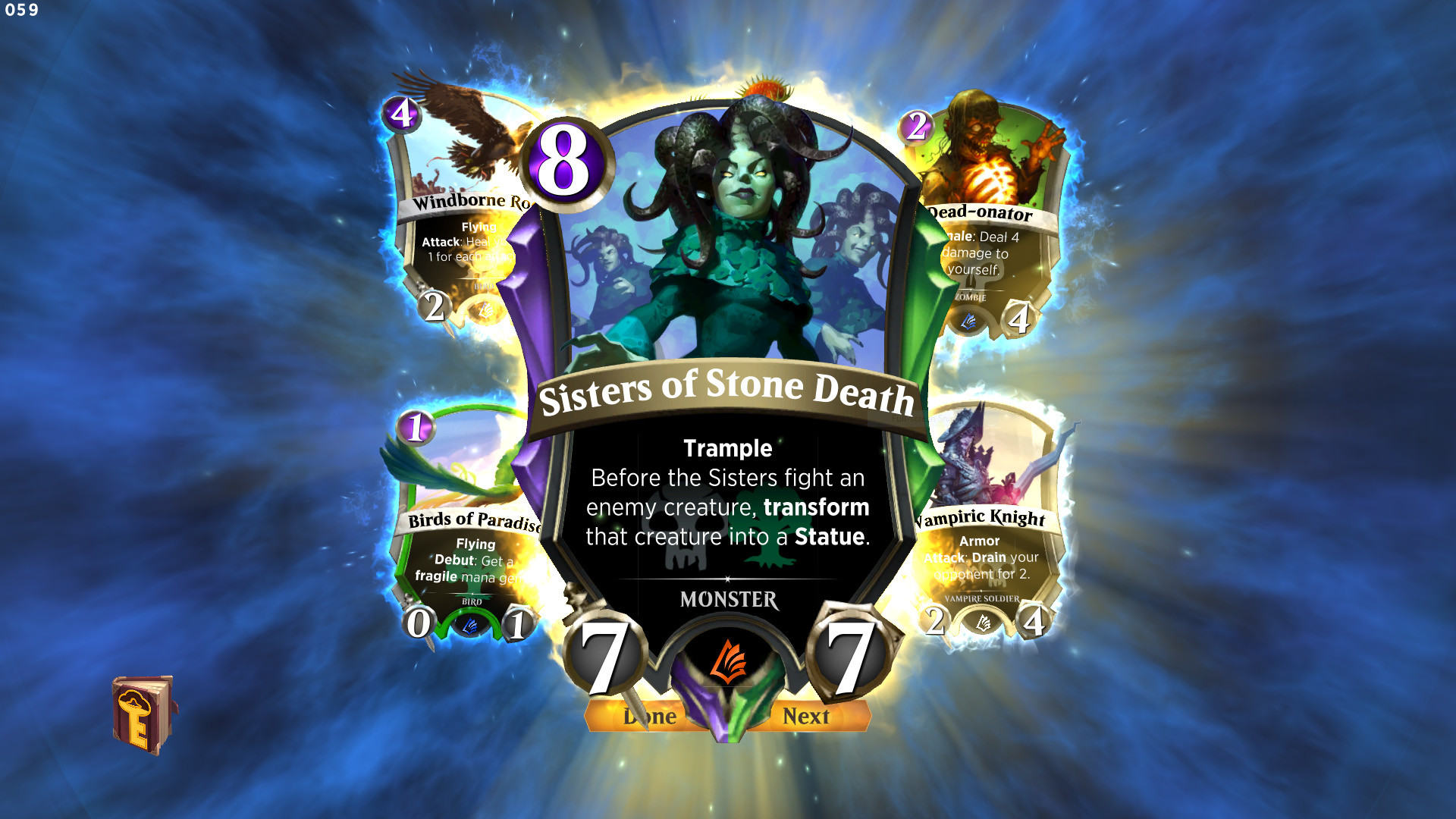
me, me, im the stone dead sister
And that’s Part II!
I spent EIGHT HOURS on the first draft of this, so I have officially lost my mind. This is my formal resignation from Sanity.
In the next installment, we’ll go over the multicolored Spellslingers of allied color pairs, in This Much Detail. See you there.
SINISTRA BLACK (she/her) is a Los Angeles-based writer-director, Transgender Anarchist killjoy, Void Witch, and infectious scorpion.
She publishes media essays and an email newsletter on her homepage, EASY ANSWERS. She can also be found on Twitter, Facebook, and other platforms, sharing humor, criticism, scorching takes, and rampant growth.
She is available for hire or decklist sharing, but only for Platinum League players and above.

